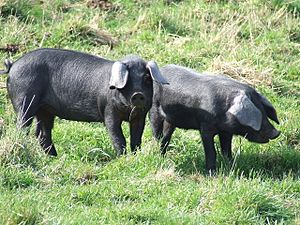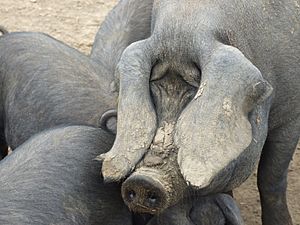Large Black pig facts for kids

Large Black boars
|
|
| Conservation status | RBST (2019): endangered |
|---|---|
| Other names |
|
| Country of origin | Great Britain |
| Traits | |
| Weight |
|
|
|
The Large Black pig is a special pig breed from Britain. It's the only British pig that is completely black. These pigs were first developed in the late 1800s. They came from black pigs living in different parts of England, like Devon and Cornwall in the southwest, and Essex, Suffolk, and Kent in the southeast.
Large Black pigs are tough and easy to handle. They also have many piglets. They are good at finding their own food, which makes them great for farms where animals roam freely. However, they don't do well in crowded, indoor farm settings.
This breed was very popular in the early 1900s and was sent to many countries. But after World War II, their numbers dropped a lot. This happened because a report suggested farmers should only raise a few pig breeds that were good for indoor farming. By the 1960s, the Large Black pig was almost gone. Even though their numbers have grown since then, they are still an endangered breed.
Contents
History of the Large Black Pig
The Large Black pig came from black pigs in two different areas of England. These were the southwest (Devon and Cornwall) and the east (Essex, Suffolk, and Kent). The pigs from eastern England were partly influenced by pigs brought from China in the late 1700s. The pigs from Devon and Cornwall were likely more like pigs found in Europe, especially France.
At first, Devon pigs were chosen for their long bodies, ears, and tails. But over time, farmers bred them to be stronger and have better bodies. By 1850, they were known for being small-boned and thick. Some people also think the black color came from black Guinea hogs from Africa or pigs from Naples, Italy.
Growing Popularity and Breed Society
The Large Black pig became more popular in the late 1800s. A group called the Large Black Pig Society was started in 1898 or 1899 in Ipswich, Suffolk. This group helped keep track of the breed. They even registered a special symbol for the breed in 1902.
The first official book about Large Black pigs was published in 1899. It brought together the black pigs from Devon and Cornwall with the remaining smaller black pigs from eastern England. Even though the pigs from these two areas looked a bit different at first, breeders exchanged pigs. By 1913, they had achieved a "general uniformity" in the breed.
From the 1920s to Today
In 1919, a Large Black sow won a top award at a big show in the UK. That same year, more Large Black pigs were shown at the Royal Show than any other breed. The breed was most popular in the 1920s. However, after World War II, farmers started to prefer pig breeds that did well in indoor, intensive farming. Because of this, the number of Large Black pigs went down. The breed society joined a larger pig breeders' group in 1949.
In 1955, a report suggested that UK pig farms should focus on only three breeds: the Welsh, the British Landrace, and the Large White. This report caused the numbers of all other British pig breeds, including the Large Black, to drop sharply. By the time the Rare Breeds Survival Trust was formed in 1973, many traditional pig breeds were almost gone. The Large Black was put on their endangered list.
Large Black Pigs in Other Countries
By 1913, Large Black pigs were found all over Britain. They were also sent to many other parts of the world, including Europe, North and South America, Africa, and Australia. The first Large Black pigs arrived in Australia around 1902 or 1903. They were chosen because they could handle hot weather, find their own food, and have many piglets.
By 1930, Large Black pigs made up only a small part of Australia's pig population. Their numbers stayed low, but there was a small increase after World War II. However, new registrations almost stopped in the 1980s. The first Large Black pigs came to the US in the 1920s. But their numbers dropped so much that more pigs had to be brought in again in 1985. Today, you can find small groups of Large Black pigs in the US, Canada, Australia, and South Africa.
Characteristics of Large Black Pigs
The Large Black pig is known for its long, deep body. It is a very tough breed and is great for extensive farming, which means raising animals outdoors in a more natural way. These pigs are excellent at foraging and grazing. They can turn poor quality food found in pastures into good meat.
It is the only pig breed in Britain that is completely black. This black skin helps protect them from sunburn in sunny places. Large Black pigs are also very calm and easy to manage. Their large, floppy ears often cover their eyes, which helps keep them from wandering off. These ears also protect their faces and eyes when they are digging in the dirt for food.
Reproduction and Litter Size
Large Black sows (female pigs) are known for being fertile for a long time and having strong motherly instincts. They usually give birth to a large litter of 8 to 10 piglets. Some sows have even had as many as 13 piglets. A famous Large Black sow is in the Guinness Book of Records for having 26 litters between 1940 and 1952. This is the most litters ever recorded for a pig!
Male Large Black pigs, called boars, can weigh around 350 kg (700 to 800 lbs). Sows weigh about 300 kg (600 to 700 lbs). The breed has gotten bigger over the years. In the early 1900s, sows usually weighed around 225 kg (500 lbs).
Meat Quality
When the Large Black pig was most popular, it was mainly raised for its meat, especially for bacon. The meat from Large Black pigs is known for being lean and flavorful, without too much back fat. For commercial farms, they were often crossed with Yorkshire and Middle White pigs. This created a strong mixed-breed pig that farmers liked. However, today, many meat processors do not prefer the black skin of purebred Large Black pigs.
Conservation Status
The Large Black pig is considered a rare breed. In 1954, there were about 2,195 Large Black pigs recorded in the UK. This was about 3.4% of all pigs in the country. By the end of 2011, there were only 421 registered Large Black pigs. This was a small increase from 2010.
The Large Black is the rarest traditional pig breed in Britain. However, their numbers are slowly going up because more people want meat from traditional pig breeds. In 2011, the Rare Breeds Survival Trust listed them as "vulnerable." This means there are believed to be between 200 and 300 breeding females. The British Pig Association keeps track of the different family lines within the breed.
In Australia, the Rare Breeds Trust listed the Large Black as "critical" in 2004. This means that fewer than 30 sows were registered each year. In the United States, the American Livestock Breeds Conservancy estimated there were about 300 breeding Large Black pigs in 2008. They also list the breed as "critical." This means fewer than 200 animals are registered each year in the US, and fewer than 2,000 are thought to exist worldwide.
Saving these pigs is important for keeping different types of farm animals (genetic diversity). The breed is also becoming popular for people who want pork from pigs raised outdoors. In Canada, only one group of Large Black pigs was found in 1997. Rare Breeds Canada now lists them as "endangered," with fewer than 500 animals in that country.


